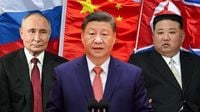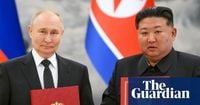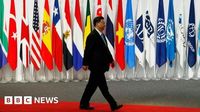Beijing is set to become the epicenter of global diplomacy and spectacle next week as Chinese President Xi Jinping, Russian President Vladimir Putin, and North Korean leader Kim Jong Un gather for a military parade marking the 80th anniversary of the end of World War II. The event, scheduled for September 3 in Tiananmen Square, is drawing leaders from at least 26 countries, but none from the United States or Western Europe, highlighting a sharp East-West divide at a moment of heightened international tension.
The parade, commemorating Japan’s surrender in 1945, will showcase more than 10,000 soldiers, over 100 aircraft, missile systems, tanks, and domestically built drones—many of which will be revealed to the public for the first time, according to Chinese officials cited by SAN. The event is not merely a display of China’s growing military prowess; it is also a stage for diplomatic maneuvering, with Xi Jinping seeking to project China as both a military heavyweight and a stable trading partner amid ongoing trade disputes with the United States.
For Kim Jong Un, this marks his first visit to China since 2019, and only his 11th foreign trip since taking power in 2011, as confirmed by North Korean state media (KCNA) and reported by CNN. His attendance signals not only North Korea’s enduring alliance with China but also a deepening relationship with Russia. As Sky News reported, Kim has been providing Vladimir Putin with troops and munitions for the ongoing war in Ukraine, a move that has drawn sharp condemnation from the West and further isolated both nations from the international community.
Putin, whose presence at the parade was confirmed earlier, is expected to stand alongside Xi and Kim at the center of the celebrations. China’s Assistant Foreign Minister Hong Lei told reporters that the Russian president’s attendance “further demonstrates the high level of the China-Russia comprehensive strategic partnership of coordination for a new era and declares the unity and solidarity between China and Russia.” Hong Lei emphasized that both countries, as founding members of the United Nations and permanent members of the Security Council, “will continue to uphold the authority of the United Nations and international fairness and justice,” as quoted by Sky News and SAN.
The guest list reads like a who’s who of leaders outside the Western sphere. According to China’s Ministry of Foreign Affairs and reporting by Reuters, attendees will include Myanmar’s military junta chief Min Aung Hlaing, Iranian President Masoud Pezeshkian, Belarusian President Alexander Lukashenko, and Indonesian President Prabowo Subianto. Pakistan’s Prime Minister Shehbaz Sharif and Slovakia’s Robert Fico—who is notably the only Western leader attending—will also be present. South Korea will be represented by Woo Won-shik, speaker of the National Assembly.
Interestingly, Indian Prime Minister Narendra Modi’s attendance remains uncertain. While Modi will be in China that week for a summit of the Shanghai Cooperation Organisation in Tianjin, diplomatic sources cited by Reuters note that India’s relationship with China has thawed recently, largely due to shared economic grievances with the United States and the fallout from President Donald Trump’s tariff war.
The parade is more than a commemoration; it’s a calculated display of unity and power at a time when the global order is in flux. As BBC analysis points out, Xi Jinping’s ability to bring Kim and Putin together for this event is a significant diplomatic coup. It not only bolsters China’s image as a central player on the world stage but also gives Xi valuable leverage in ongoing negotiations with Washington, especially as President Trump has expressed a renewed interest in meeting Kim Jong Un. The timing is no accident—Xi’s hand is strengthened ahead of any future summits with the U.S., and his close ties to both Kim and Putin may provide him with insights or influence that his American counterpart lacks.
China’s role as North Korea’s economic lifeline cannot be overstated. As BBC notes, Beijing supplies nearly 90% of North Korea’s food imports, making the relationship one that Kim is unlikely to jeopardize. Meanwhile, Moscow and Pyongyang have drawn closer since the start of the war in Ukraine, with North Korea supplying both munitions and soldiers to support Russian forces. This strengthening triangle of cooperation is underpinned by formal agreements as well—last year, North Korea and Russia signed a security pact pledging mutual military assistance if either comes under attack, according to The Washington Post.
The tightening links between these three nations are not limited to diplomatic gestures. Earlier this month, Chinese and Russian navies conducted a joint submarine patrol in the Pacific—their first such operation—covering the Sea of Japan and the East China Sea, a move that Global Times described as evidence of high-level trust between the two militaries. At the same time, North Korea has accelerated its nuclear and missile programs, with significant help from Russia. Analysts told The Washington Post that Russian technology transfers and training have enabled Pyongyang to make rapid advances, including the introduction of tactical nuclear warheads, multi-warhead missiles, and progress toward nuclear-powered submarines.
These developments have raised alarms in Washington, Seoul, and other regional capitals. Go Myong-hyun, a senior research fellow at Seoul’s Institute for National Security Strategy, warned, “In the future, if the North Koreans detect the right timing, they can really cause a huge amount of instability in the region.” The parade, then, is not just a celebration of past victories but a signal of future intentions and capabilities.
As the world watches, the absence of U.S. and Western European leaders from the event speaks volumes. While President Trump continues to push for negotiations to end the war in Ukraine and recalibrate America’s alliances, the Beijing gathering underscores the emergence of an alternative power bloc—one that is willing to challenge the Western-led order and assert its own vision of global governance.
For Xi Jinping, the parade is both a show of military might and a masterstroke of diplomacy. By bringing together Kim and Putin at a moment of strategic uncertainty, he is sending a message to Washington and beyond: China is not just a participant in world affairs, but a power broker with the ability to shape outcomes. Whether this new alignment leads to greater stability or deeper divisions remains to be seen, but for now, all eyes are on Tiananmen Square.



